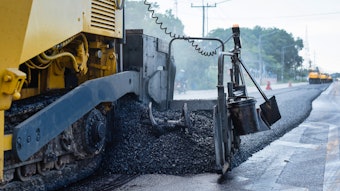As the cost of oil continues to rise, impacting the cost of hot mix asphalt, communities and even commercial properties are more and more considering mill-and-fill operations to stretch their maintenance and construction dollars.
But these mill-and-overlay operations can be slowed when catch basins and manholes need to be reconstructed to grade, so adjustable risers have begun to play an increasingly important role in pavement maintenance.
According to Scott Fier, president of sales and marketing for American Highway Products, two communities that perform much of their own work, St. Louis and San Francisco, now rely on adjustable risers to make the job easier and provide a better finished paving job.
"Both cities have rehabilitation programs in place that call for the use of adjustable risers," Fier says. "The use of adjustable risers enables them to make more repairs quicker and for fewer dollars, which enables them to improve more of their city streets."
He says St. Louis, San Francisco, and other communities interested in rebuilding the profile of a road and returning the crown to it are turning to pavement milling to remove two inches of existing pavement before the new surface is constructed. "They come in and mill off two inches, but because the road isn't flat some utility structures need to be raised one inch and some need to be raised two inches."
He says adjustable risers are available in 1/4-inch increments up to 5 3/4 inches but says that 90% of all adjustments are less than two inches.
Fier says the old fashioned approach was a slow, cumbersome, and expensive process costing as much as $400 per manhole. That approach, which could be done either in advance of the paver or after the paver, required jackhammering the pavement around the casting, removing the debris, lifting the casing (which requires a separate piece of equipment), and reconstructing the supporting brickwork or concrete. Once the casting was raised and replaced the contractor had to backfill around it and repave and compact.
"Often there's a settling of this backfill, what some people call 'dishing,' for two or three feet around the existing casting. It looks raised but it's not. Instead the area around it has sunk."
Fier says that doesn't occur with adjustable risers, however, because they don't require destruction of surrounding pavement, don't require removal of the existing casting, and don't require reconstruction of the brickwork. The result is a quicker and less-expensive process.
"It varies but the average cost using an adjustable riser is about $100 per casting, and that's a big savings in both time for the contractor and dollars for the customer," Fier says.
Fier says installing adjustable risers is quick to learn and easy to do. Once the manhole lid is removed the contractor needs to clean the seat and sidewalls of the existing frame. "Some contractors will even whisk it out with a broom to make sure the riser sits flat in there," Fier says.
The adjustable riser is then placed inside the frame, and using a screwdriver the riser is expanded to fit tight, generally to about 60 lbs. of pressure. "When it's expanded tight it's not going to come loose with traffic or when snowplows go over it," Fier says.
Once the riser is installed the contractor can put the lid back on and the job is finished.
He says most adjustable risers, roughly 60%, are sold to cities with the remaining 40% sold to contractors. "But many of the ones we sell to cities are ordered and paid for by them but they give them to the contractors to install," he says.


























